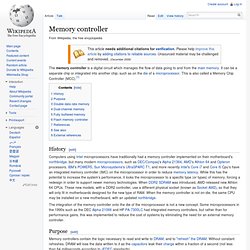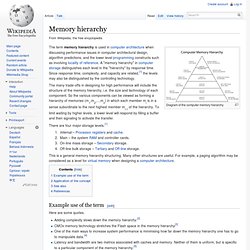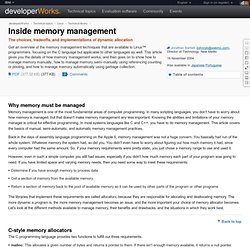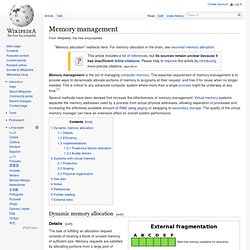

Memory controller. History[edit] The integration of the memory controller onto the die of the microprocessor is not a new concept.

Some microprocessors in the 1990s such as the DEC Alpha 21066 and HP PA-7300LC had integrated memory controllers, but rather than for performance gains, this was implemented to reduce the cost of systems by eliminating the need for an external memory controller. Purpose[edit] Memory controllers contain the logic necessary to read and write to DRAM, and to "refresh" the DRAM. Without constant refreshes, DRAM will lose the data written to it as the capacitors leak their charge within a fraction of a second (not less than 64 milliseconds according to JEDEC standards). Memory hierarchy. Diagram of the computer memory hierarchy The term memory hierarchy is used in computer architecture when discussing performance issues in computer architectural design, algorithm predictions, and the lower level programming constructs such as involving locality of reference.

A "memory hierarchy" in computer storage distinguishes each level in the "hierarchy" by response time. Since response time, complexity, and capacity are related,[1] the levels may also be distinguished by the controlling technology. The many trade-offs in designing for high performance will include the structure of the memory hierarchy, i.e. the size and technology of each component. So the various components can be viewed as forming a hierarchy of memories (m1,m2,... There are four major storage levels.[1] Internal – Processor registers and cache.Main – the system RAM and controller cards.On-line mass storage – Secondary storage.Off-line bulk storage – Tertiary and Off-line storage.
Memory Management. Inside memory management. Why memory must be managed Memory management is one of the most fundamental areas of computer programming.

In many scripting languages, you don't have to worry about how memory is managed, but that doesn't make memory management any less important. Knowing the abilities and limitations of your memory manager is critical for effective programming. In most systems languages like C and C++, you have to do memory management. This article covers the basics of manual, semi-automatic, and automatic memory management practices. Back in the days of assembly language programming on the Apple II, memory management was not a huge concern. However, even in such a simple computer you still had issues, especially if you didn't how much memory each part of your program was going to need.
LDP/tlk/mm/memory.html. Table of Contents, Show Frames, No Frames The memory management subsystem is one of the most important parts of the operating system. Since the early days of computing, there has been a need for more memory than exists physically in a system. Strategies have been developed to overcome this limitation and the most successful of these is virtual memory. Virtual memory makes the system appear to have more memory than it actually has by sharing it between competing processes as they need it. Virtual memory does more than just make your computer's memory go further.
The Memory Management Reference: Beginner's Guide: Overview. Beginner's Guide: Overview | Allocation techniques | Recycling techniques Memory management is a complex field of computer science and there are many techniques being developed to make it more efficient. This guide is designed to introduce you to some of the basic memory management issues that programmers face. Some platforms have specific problems in dealing with memory, which are not covered in depth here. In particular, if you are looking for information on configuring memory under DOS or Windows (EMS, XMS, HIMEM.SYS, and the like), then you won't find The Memory Management Reference very useful.
This guide attempts to explain any terms it uses as it introduces them. The Memory Management Reference. Memory management. Several methods have been devised that increase the effectiveness of memory management.

Virtual memory systems separate the memory addresses used by a process from actual physical addresses, allowing separation of processes and increasing the effectively available amount of RAM using paging or swapping to secondary storage. The quality of the virtual memory manager can have an extensive effect on overall system performance. Dynamic memory allocation[edit] External Fragmentation Details[edit] Efficiency[edit] Implementations[edit] Fixed-size blocks allocation[edit] Buddy blocks[edit] Lecture Schedule.